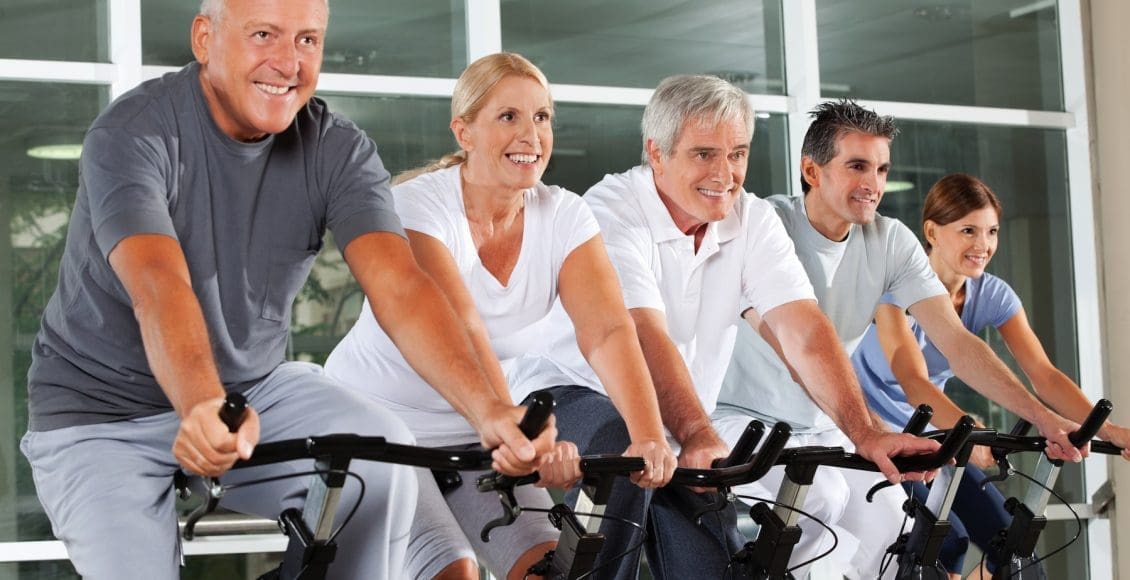High-intensity exercise may help older adults reverse certain aspects of the “cellular” aging process, a new study suggests.
It’s no secret that regular exercise is healthy for young and old alike. But researchers said the new findings point to particular benefits from “high-intensity interval training” for older adults. That’s the type of workout that combines brief bursts of vigorous exercise with periods of moderate activity: A person might, for example, go all-out on a stationary bike for a few minutes, ease up for the next few, and then start again.
In this study, older adults who performed that type of exercise showed greater changes at the cellular level, compared to those who worked out more moderately. Specifically, interval training gave a bigger boost to mitochondrial function in the muscle. Mitochondria are the “powerhouses” within body cells that break down nutrients to be used for energy. The training also revved up activity in more genes related to mitochondrial function and muscle growth.
Table of Contents
How Exercise Can Help the Aging Process
The study findings suggest that interval training can turn back the clock in ways that moderate aerobic exercise and strength training do not, according to lead researcher Dr. K. Sreekumaran Nair. But, he stressed, the findings do not mean older adults should jump into a vigorous exercise regimen.
“If you’re sedentary, you should talk to your doctor before you start exercising,” said Nair. He’s an endocrinologist at the Mayo Clinic in Rochester, Minn. “And then,” he said, “you can start with walking, and build yourself up to a fast pace.” For older adults who want to progress to a more-intense regimen, Nair said, it’s best to start with supervision. But he also stressed that intense exercise is not a must. “Any regular exercise will bring health benefits — absolutely,” he added.
This study demonstrated that, he pointed out. Even though interval training had the biggest effects on aspects of cellular aging, other types of exercise boosted older adults’ fitness levels and muscle strength.
Benefits of Exercise in Adults Study
The study, published recently in Cell Metabolism, involved 72 younger and older adults who were sedentary.
Nair’s team randomly assigned each of them to one of three supervised exercise groups. One group did high-intensity interval training three days a week: They pedaled on an exercise bike at their maximum speed for 4 minutes, before easing up for 3 minutes; they repeated that process four times. They also worked out more moderately — walking on a treadmill — twice a week.
A second group performed moderate aerobic exercise — using an exercise bike at a less-intense pace — five days a week, for 30 minutes. They also did some light strength-training four days a week.
The third group performed strengthening exercises only, two days a week.
After 12 weeks, all of the groups were showing positive changes — younger and older exercisers alike, the researchers found.
People who performed moderate aerobic exercise boosted their fitness levels — the body’s ability to supply blood and oxygen to working muscles. And the improvement was greater for older adults, who generally started out with lower fitness levels than younger people. Meanwhile, people who performed strength-training — alone or with aerobic exercise — increased their muscle strength.
The interval-training group showed only small gains in strength. But the training improved mitochondrial function in the muscles, especially among older adults.
Dr. Chip Lavie is medical director of cardiac rehabilitation and prevention at the John Ochsner Heart and Vascular Institute in New Orleans. He said this is a “great” study that demonstrates the benefits of different forms of exercise. According to Lavie, it adds to other evidence that high-intensity interval training is “probably the best form of exercise.”
Many studies, he said, have found that interval training beats moderate aerobic exercise when it comes to improving fitness and the heart’s structure and function.
“It would be ideal to get more people to do high-intensity interval training,” Lavie said, “and it’s possible for more-motivated individuals.” But, he added, the reality is, many people may not have the motivation or ability.
In that case, Lavie advised finding a moderate regimen you can live with — such as 30 to 40 minutes of walking or using an exercise bike or elliptical machine most days of the week.
SOURCES: K. Sreekumaran Nair, M.D., Ph.D., professor, medicine, Mayo Clinic, Rochester, Minn.; Chip Lavie, M.D., medical director, cardiac rehabilitation and prevention, and director, exercise laboratories, John Ochsner Heart and Vascular Institute, New Orleans; March 7, 2017, Cell Metabolism
For more information, please feel free to ask Dr. Jimenez or contact us at 915-850-0900 .
Additional Topics: Chiropractic Care for Older Adults
With the progression of age, it’s common for the human body to naturally begin to degenerate. Although degenerative changes in the body are normal, it’s also common for complications associated with aging to develop. Chiropractic care is a safe and effective, alternative treatment option utilized by many individuals to prevent, diagnose and treat injuries and conditions associated with the structures of the spine. Research studies have demonstrated that chiropractic treatment can help older adults find relief from their neck pain and back pain.
.video-containerposition: relative; padding-bottom: 63%; padding-top: 35px; height: 0; overflow: hidden;.video-container iframeposition: absolute; top:0; left: 0; width: 100%; height: 100%; border: none; max-width:100%!important;
TRENDING TOPIC: EXTRA EXTRA: New PUSH 24/7Â®ï¸ Fitness Center
Post Disclaimer
Professional Scope of Practice *
The information herein on "Exercise Helps Reverse Cellular Aging Process in Adults" is not intended to replace a one-on-one relationship with a qualified health care professional or licensed physician and is not medical advice. We encourage you to make healthcare decisions based on your research and partnership with a qualified healthcare professional.
Blog Information & Scope Discussions
Welcome to El Paso's Premier Wellness, Personal Injury Care Clinic & Wellness Blog, where Dr. Alex Jimenez, DC, FNP-C, a Multi-State board-certified Family Practice Nurse Practitioner (FNP-BC) and Chiropractor (DC), presents insights on how our multidisciplinary team is dedicated to holistic healing and personalized care. Our practice aligns with evidence-based treatment protocols inspired by integrative medicine principles, similar to those found on this site and our family practice-based chiromed.com site, focusing on restoring health naturally for patients of all ages.
Our areas of multidisciplinary practice include Wellness & Nutrition, Chronic Pain, Personal Injury, Auto Accident Care, Work Injuries, Back Injury, Low Back Pain, Neck Pain, Migraine Headaches, Sports Injuries, Severe Sciatica, Scoliosis, Complex Herniated Discs, Fibromyalgia, Chronic Pain, Complex Injuries, Stress Management, Functional Medicine Treatments, and in-scope care protocols.
Our information scope is multidisciplinary, focusing on musculoskeletal and physical medicine, wellness, contributing etiological viscerosomatic disturbances within clinical presentations, associated somato-visceral reflex clinical dynamics, subluxation complexes, sensitive health issues, and functional medicine articles, topics, and discussions.
We provide and present clinical collaboration with specialists from various disciplines. Each specialist is governed by their professional scope of practice and their jurisdiction of licensure. We use functional health & wellness protocols to treat and support care for musculoskeletal injuries or disorders.
Our videos, posts, topics, and insights address clinical matters and issues that are directly or indirectly related to our clinical scope of practice.
Our office has made a reasonable effort to provide supportive citations and has identified relevant research studies that support our posts. We provide copies of supporting research studies upon request to regulatory boards and the public.
We understand that we cover matters that require an additional explanation of how they may assist in a particular care plan or treatment protocol; therefore, to discuss the subject matter above further, please feel free to ask Dr. Alex Jimenez, DC, APRN, FNP-BC, or contact us at 915-850-0900.
We are here to help you and your family.
Blessings
Dr. Alex Jimenez DC, MSACP, APRN, FNP-BC*, CCST, IFMCP, CFMP, ATN
email: coach@elpasofunctionalmedicine.com
Multidisciplinary Licensing & Board Certifications:
Licensed as a Doctor of Chiropractic (DC) in Texas & New Mexico*
Texas DC License #: TX5807, Verified: TX5807
New Mexico DC License #: NM-DC2182, Verified: NM-DC2182
Multi-State Advanced Practice Registered Nurse (APRN*) in Texas & Multi-States
Multistate Compact APRN License by Endorsement (42 States)
Texas APRN License #: 1191402, Verified: 1191402 *
Florida APRN License #: 11043890, Verified: APRN11043890 *
License Verification Link: Nursys License Verifier
* Prescriptive Authority Authorized
ANCC FNP-BC: Board Certified Nurse Practitioner*
Compact Status: Multi-State License: Authorized to Practice in 40 States*
Graduate with Honors: ICHS: MSN-FNP (Family Nurse Practitioner Program)
Degree Granted. Master's in Family Practice MSN Diploma (Cum Laude)
Dr. Alex Jimenez, DC, APRN, FNP-BC*, CFMP, IFMCP, ATN, CCST
My Digital Business Card
RN: Registered Nurse
APRNP: Advanced Practice Registered Nurse
FNP: Family Practice Specialization
DC: Doctor of Chiropractic
CFMP: Certified Functional Medicine Provider
MSN-FNP: Master of Science in Family Practice Medicine
MSACP: Master of Science in Advanced Clinical Practice
IFMCP: Institute of Functional Medicine
CCST: Certified Chiropractic Spinal Trauma
ATN: Advanced Translational Neutrogenomics






 Again, We Welcome You.
Again, We Welcome You.
Comments are closed.